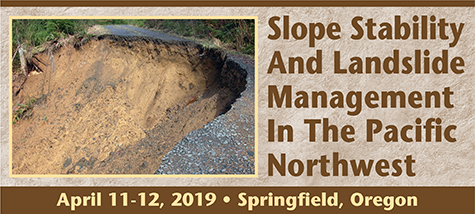Slope Stability and Landslide Management in the Pacific Northwest

Location: Springfield, OR
April 11, 2019
9:00 Slope Movement and Mechanisms
Types of Slope Movement and Instabilities.
- What is a landslide?
- What drives landslides to occur?
- How to identify landslide features in the field.
- Rock-fall and rockslides.
- Translational and rotational failures.
- Debris flows and rapidly moving landslides.
- How to recognize landslide types.
10:30 Break
10:45 Slope Movement and Mechanisms, (continued)
Slope stability concepts
- Assessing driving and resisting forces.
- Reviewing geologic conditions.
- Examining soils and topography.
- Evaluating surface and groundwater conditions.
- Methods of slope stability analysis.
- Natural slopes versus engineered slopes.
Noon Lunch
1:00 Identification of Landslide Features using Remote Sensing Data
- Basic Features of Landslides
- Identifying Landslide Features using Aerial Photography
- Identifying Landslide Features using Contour Maps/Digital Elevation Models
- Identifying Landslide Features using LiDAR
- Available State Resources and Landslide Inventories
- Class Mapping Exercise
2:30 Slope Stabilization Methods
- Drainage
- Use of Vegetation (Bioengineering)
- Surface Protection
- Unloading
- Buttressing and Shear Keys
- Installing Earth Retention Structures
- MSE Walls
- Reinforced Steep Slopes
- Soil Nails
- Scaling, Containment, and Rockfall Mitigation
3:30 Slope Stabilization Case Studies
- Examples of Slope Stabilization Using Retaining Walls
- Examples of Slope Stabilization Using Geosynthetics
- Examples of Slope Stabilization Using Earthworks
- Shear keys and buttresses
- Unloading
- Examples of Slope Stabilization Using Drainage
4:30 Adjourn
April 12, 2019
8:30 Landslide Hazard and Risk Assessment
- Definitions and Elements of Landslide Hazard and Risk
- Risk-reduction Strategies (objectives for landslide mitigation)
- Considerations for Harvest Layout.
- Applications
10:00 Break
10:15 Introduction to Soil Mechanics
- Soil and Rock Mechanics
- Basic soil and rock properties
- How are soil properties measured?
- The influence of water
Noon Lunch
1:00 Application of Slope Stability Analysis
- Coulomb Wedge
- Infinite Slope
- Bishop’s Method
- Consideration of Water, Seismic, and Reinforcement
- Back-Analysis
2:30 Activity – Applying Slope Stability Analyses with Computers
Activity – Applying Slope Stability – Exercises (with answers)
- Coulomb Wedge
- Infinite Slope
- Bishop’s Method
4:30 Adjourn
About the Instructors:
Curran Mohney is presently the Engineering Geology Program Leader for the Oregon Department of Transportation. The Engineering Geology Program at ODOT encompasses site characterization, subsurface exploration, slopes and embankments, geologic hazards, groundwater, geotechnical instrumentation, and planning and research activities. In this role, he also oversees the Unstable Slopes (Landslide/Rockfall) program for ODOT.
Curran is a Registered Geologist and Certified Engineering Geologist in Oregon with over 25 years of experience in Oregon and the Western States. He has been the Engineering Geology Program Leader since 2004. Prior to this, he has been a Staff and Project-level geologist for Consulting firms and the Mining Industry as well as for ODOT. He is a graduate of the Geology program at Portland State University.
Ben Leshchinsky is an Associate Professor, Geotechnical Engineering with a dual appointment in the School of Civil and Construction Engineering and College of Forestry at Oregon State University in Corvallis, OR. He has a B.S., M.S. and Ph.D in Civil Engineering with a professional engineering license in Oregon. Ben’s areas of interest include: landslides, slope stability, earth retaining structures, railroad engineering, geosynthetics, behavior of granular materials, degradation of granular materials, and reinforced soil. He has taught OSU classes on soil engineering, soil mechanics and designing with geosynthetics.
Rene’ Renteria is the Regional Geotechnical & Dam Safety Engineer for the USDA Forest Service, Pacific Northwest and Alaska regions. Rene’ is a graduate of the civil and forest engineering programs at OSU, started his professional career on the Willamette National Forest back in the 1980s, and has 35 years of experience with transportation structures and slope stability in the mountain ranges of the Pacific Northwest and Intermountain West, including 10 years with the Oregon DOT. He is a contributing author to the Forest Service publication Slope Stability Reference Guide for National Forests in the United States. His current responsibilities include geotechnical, pavements, and dams engineering on the national forests in Oregon, Washington, and Alaska. Rene’ is a registered Professional Engineer in Oregon.

